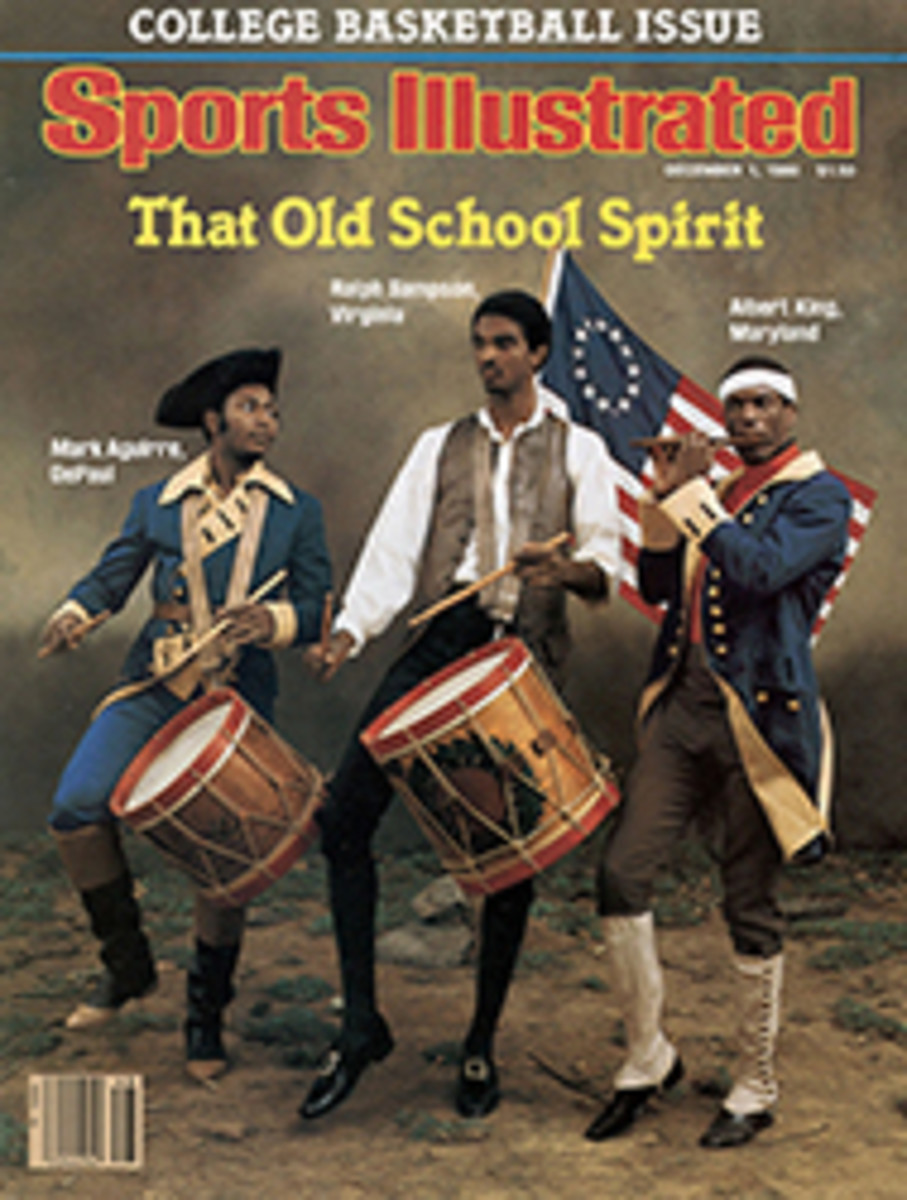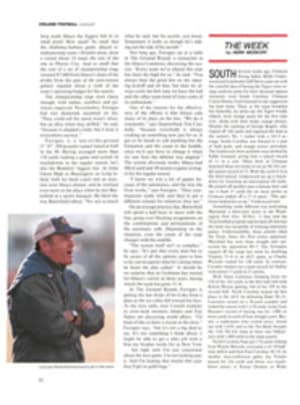
A big one who thought small
Last year when Wil Jones was setting up shop for his first season as coach at the University of the District of Columbia, one of the things he hung on his office wall was a size-18 sneaker. "For us to be successful we have to get the guy who can fill that shoe," he would say. Like every other coach, Jones was looking for the ultimate big man, the Franchise, who, through his scoring, rebounding and intimidation, could make his Firebirds an NCAA Division II national title contender. Now, Jones and UDC may have him. In the most amazing recruiting coup the college game has seen in recent years, the coach persuaded 6'11", 215-pound Earl Jones (no relation), the most highly publicized high school player in the nation last season, to forsake the glamorous heavyweights of Division I for Division II UDC. Although Earl, who's 19 years old, doesn't quite fit the sneaker his coach had reserved for him—his shoe size is a mere 14—his extraordinary court talents should give fans at the four-year-old school plenty of kicks.
"I don't know how good he's going to be, but if he comes off wrong they'll say I messed him up," Wil says. "The only thing he can do is hurt my reputation." Earl's picture hangs in a special high school exhibit at the Basketball Hall of Fame in Springfield, Mass., and no wonder. In four seasons of high school competition, the first three at tiny (enrollment 450) Mt. Hope (W. Va.) High and last season at Washington's Spingarn High, Earl averaged 28 points, 18 rebounds and 13 blocked shots per game. He has the speed and passing skills that coaches look for in point guards. He has a feathery one-handed touch from long range and can dribble well enough to break a press by himself. "He's so talented it's frightening," says Coach Jerry Tarkanian of Nevada-Las Vegas. Tarkanian might have enjoyed the scare of his life had Earl met the 2.0 cumulative minimum grade-point average required by the NCAA to play major college basketball. Las Vegas and UCLA were the two Division I schools Jones considered most seriously. "If we had him, we'd be the favorite to win the NCAA title," Tarkanian says, "but a lot of schools could say that."
When Earl made the Mt. Hope varsity as a freshman in 1977, he joined a team that was 3-18 the previous season and hadn't made the West Virginia state playoffs since 1927. Over the next three seasons, as Mt. Hope won 63 of 72 games, Earl drew comparisons to Kareem Abdul-Jabbar. But while his reputation grew, so did the pressure on him. Unlike his personality on the court, which is fairly animated, Earl is a shy, reticent young man who is distrustful of strangers. In high school he was overwhelmed by recruiters and reporters who wanted "just a few minutes" of his time. Mt. Hope fans came down on him because of their team's failure to win the state championship. After a while the heat became so intense that Earl began staying away from school.
By the end of his junior year, he had 63 unexcused absences and was failing most of his classes. He also learned that he was to become a father—the child, a girl named Tanishia, is now two. Realizing that the environment of Mt. Hope was becoming intolerable for her son, Margaret Jones sent him to Washington, where three of his older sisters live, and temporarily withdrew him from school.
After an absence of 10 days, Earl returned to Mt. Hope and took makeup examinations that gave him passing grades in the necessary courses. He also was visited by William (Doc) Robinson, a District of Columbia recreation director and AAU basketball coach. Robinson was aware of the youngster's problems at Mt. Hope and also knew that Earl wouldn't be playing on an AAU team that summer because West Virginia didn't have one in his age bracket.
Robinson's team, which was to play in a National AAU Youth tournament in Jacksonville, Fla., needed a center to fill out an already glittering roster. "One of my players told me that Ralph Sampson was all right but that Earl was better because he passed the ball," says the coach. That was enough for Robinson, who drove the 500 miles to the Jones' house despite Margaret's warning over the phone that Earl would probably refuse to see him. Earl didn't know Robinson was coming, and, sure enough, he stayed in his bedroom when the coach arrived. After an hour of waiting, Robinson's patience wore thin. "At first, he wasn't going to come out, but he came out when I told him I was coming in," Robinson says. Jones finally consented to play for Robinson's team, which came in second in the tournament. Earl and Robinson developed such a close relationship that when Earl returned to Mt. Hope, he told his family he had decided to move to the coach's Washington home and attend nearby Spingarn High, a school with a large, primarily black enrollment. There Earl found the relative obscurity and relaxed atmosphere he needed.
Despite Jones' near-perfect attendance and improving grades during the fall semester at his new school, the Washington Interhigh Coaches Association notified him the day after his first practice with the Spingarn team that he was ineligible until the beginning of the conference season. The reason: poor attendance back at Mt. Hope.
Robinson got a temporary restraining order from the D.C. Circuit Court that allowed Jones to play in the Green Wave's first four non-conference games, but the judge eventually ruled in favor of the suspension. After missing six games, Jones was again allowed to play. Averaging 20.2 points and 17.0 rebounds per game, he led Spingarn to a 26-2 record and a league title; he scored 29 points in a 79-68 victory over DeMatha High for the city championship. Under the strict supervision of Robinson and Spingarn Coach John Wood, Jones also did better in the classroom, but not even his 3.5 average last spring was enough to raise his cumulative average to the acceptable NCAA level.
Earl might have attended prep school or junior college had he really wanted to go to a major college eventually, but on June 9 he told a press conference he would stay in Washington and play at UDC. "I would've gone there even if I'd got the 2.0," he says. "If I'd gone to Vegas or UCLA I would've had to live up to the play of Kareem or Walton or someone else. I wanted a setting where I wouldn't have to live up to anybody."
By adding Jones to a starting lineup that includes last season's top three scorers, the Firebirds, who were 16-11 in 1979-80, will probably be the best small-college team in the country. "We went from being a good team to being superb in a hurry," says Wil Jones, a man who doesn't mind tossing out superlatives—about either his team or himself. Indeed, Earl may not even lead the team in scoring. That distinction should fall to sophomore Forward Michael Britt. Britt averaged 23.4 points in the 16 games he was able to play last season before an error in his General Equivalency Diploma score forced him to withdraw from school. Now he's back. Muscular 6'6" Steve Smith, who had 12.7 rebounds a game, fills out the frontcourt. Playmaker Michael (Hawkeye) Daniels teams with sophomore Greg Carson to give the Firebirds a swift, aggressive backcourt. "These kids don't think they can lose," says Wil. Certainly Earl figures he's on the way up. He told The Washington Star's Betty Cuniberti last week, "All I want is to be a pro and drive an Eldorado."
The Firebirds had better win, because Wil admits he's not very gracious in defeat. "I ain't done much losing. I ain't fooling nobody. Everybody knows how I am," he says. Georgetown Coach John Thompson certainly knows. He remembers Wil as an All-Metropolitan guard at Dunbar High and as an All-America at American University. "He was the Muhammad Ali of basketball," says Thompson. "He was an extremely confident person on the court, and he could be very aggravating, but I like him."
Wil spent 4½ seasons in the NBA, the ABL and the ABA before becoming a high school coach. He later joined Lefty Driesell's staff at Maryland as an assistant coach and chief recruiter, and in the spring of 1979 he took the District of Columbia job. He didn't know it at the time, but when he signed Britt for UDC, he was also laying the groundwork for getting Jones, because the two players became good friends. "You see him, you see me," says Earl, who also took a liking to Wil when he came recruiting. Robinson says he didn't get involved in Earl's recruiting process, but it didn't hurt UDC that he and Wil are old friends. Robinson is now a part-time coach for the Firebirds. "We're not going to sneak up on anyone," says Wil. "But we got the big guy, and we're going to have some fun."
Two of the Firebirds' opponents this season will be in the thick of the Division II championship race: Wright State of Ohio and St. Augustine's of North Carolina, which have four starters back from teams that finished 25-3 and 24-7, respectively. Upsala of New Jersey seems ready to improve on its second-place Division III finish of last season. Cameron of Oklahoma, Wisconsin-Eau Claire and Alabama State will contend for the NAIA title.
PHOTO
The whole town's talking about the Jones boy and what he'll do for UDC.

